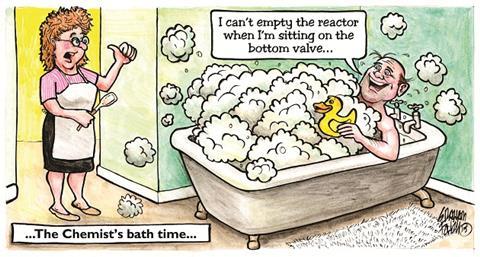Turning a 1000 gallon reactor into a giant bubble bath is far from soothing, says Chemjobber
Nothing stops a plant process faster than the dread words ‘we have a stuck bottom valve’. A 1000 gallon reactor – with hundreds of kilograms of product two steps into a three-step sequence – was being held up. Not by a broken agitator, or a lack of manpower, but a two inch pipe jammed full of product.

Bottom valves are a funny aspect of fine chemical manufacture: no matter the size and shape of a reactor, there needs to be an opening where the product comes out. It goes into a pipe, with a valve to keep it closed when the reaction is running and open when it is time to drain the reactor. While it is the responsibility of the process chemist to make sure it doesn’t happen often, inevitably the valve gets blocked with solid product (in most cases a suspension) and the process comes to a halt.
There are lots of different ways to clear a stuck bottom valve. Moving the handle back and forth can dislodge the stuck product. An unpopular solution can be unhooking the hoses from the bottom valve and physically removing the stuck material with a hook: a dirty job and one that is unlikely to actually improve the situation, as the next time the valve is turned, it’s likely another chunk of product will get stuck in there all over again.
No, the best way to deal with a stuck bottom valve is pressure. For the sake of safety (and economics), nitrogen is the inert gas of choice. The operator can inject nitrogen into the pipework below the bottom valve and blow the valve clear. Ideally, any pieces of product in the bottom valve will be dislodged and the product will flow smoothly towards its destination once more.
And yet, that day, nitrogen up the bottom valve had made no impact. As the operators persevered, forcing more pressurised nitrogen into the reactor, they had created a truly enormous froth. When I looked into the top sight glass of the reactor (a good three metres above the bottom), I saw nothing but foam. It was like peering into a washing-up bowl, but with an inch of glass in between.
Of course, the operators who had got themselves into this pretty pickle had long headed home (these things always seem to happen on the overnight shift). A senior operator informed me that the entire 1000 gallon reactor was filled with a foam of product and solvent, to the point that it had actually filled past the top of the reactor, and the foam had reached the glass-lined steel condenser bolted to the top.
We had created the world’s biggest (and possibly least inviting) bubble bath
It’s not very often that one sees foam in a fine chemical plant. Foam is broadly defined as a mixture of gas and either liquid or solid. Soap suds are a familiar foam, where the amphiphilic soap combines with water and air to make bubbles that can delight children before they pop. This was a longer-lasting foam, and much less pleasing.
Chemists occasionally see foam in the laboratory. I was pleasantly surprised as a young undergraduate to be concentrating a carbohydrate derivative on the rotary evaporator; I transferred the still-warm oil to a vacuum pump only to see it foam up into the most beautiful iridescent bubbles. (I presume the final remnants of the suddenly-evaporated solvent provided the impetus for the foam to form.) The hardened bubbles were crunchy and made an audible breaking sound when I chipped it out from the flask.
There are antifoaming chemicals to prevent this situation, and defoaming compounds to knock down the foam once it has formed. Among these are hydrophobic compounds with long hydrocarbon chains and silicon-oxygen backbones that will reduce the surface tension of bubbles that make up the foam. This encourages the smaller bubbles to fuse to make larger bubbles, which can finally float their way to the top of the solution.
Antifoaming agents aren’t just for puzzled process chemists at chemical plants, either; fast food french fries also contain a small amount of polydimethylsiloxane to prevent foaming of the cooking oil. (If PDMS has a taste at that minute quantity, I haven’t noticed.)
So what did we do that day? (I could not convince myself to use a defoamer in this reaction, due to the possibility of contaminating subsequent synthetic steps.) We added slightly more of a polar solvent into the reactor. Slowly, the foam died down and we were able to pump out the reactor to the centrifuge.
From that point on, we put explicit instructions in the batch production record to break up the material into small pieces when loading the reactor. We also did our best to remind our operators to avoid clearing the bottom valve with nitrogen and creating the world’s biggest (and possibly least inviting) bubble bath.
Chemjobber is a process chemist and blogger based in the US












No comments yet